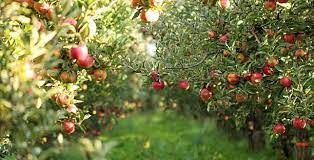JAMMU: Jammu and Kashmir is all set to revolutionize its fruit industry with introduction of High-Density Plantation (HDP) system and production of quality planting material.
The Department of Horticulture, in collaboration with Sher-e-Kashmir University of Agricultural Sciences and Technology (SKUAST) and Indian Council of Agricultural Research-Central Institute of Temperate Horticulture (ICAR-CITH), have ventured together to provide technological intervention for this new project. The goal is to make Jammu and Kashmir a self-reliant bio-economy by harnessing the economic potential of its diversified fruit crops.
The project aims to enhance the production capacity of planting material to 111 lakh in the first five years, develop 390 hectare of nurseries in public and private sectors, rejuvenate 2,000 hectare of orchard areas and produce planting material to cover 5,500 hectare under HDP of 12 fruit crops. Additionally, the project aims to strengthen plant testing and quality control, tissue culture and virus indexing labs besides building capacity by training 5,000 farmers and 150 technical manpower from SKUAST and the Department of Horticulture. The project shall create 200 new enterprises in the form of HD nurseries and provide potential jobs to 25000 persons.
“The current lack of quality planting material in the region limits the potential of the fruit industry and costs the region approximately Rs. 500 crore in imports, which also brings in new pests and diseases”, said Atal Dulloo, Additional Chief Secretary, Agriculture Production Department. “The mission of the project is to domestically produce quality planting material, reduce imports, prioritize high-density plantation of fruit crops, transform old orchards into more productive orchard systems, and diversify the JK fruit industry to capture the national and international market.”, he added.
“Production of Designer Plants for Promotion of High-Density Plantation and Rejuvenation of Orchards” is one among the 29 projects, which were approved by the Jammu and Kashmir administration after being recommended by the UT Level Apex Committee for holistic development of Agriculture and allied sectors in UT of J&K. The prestigious committee is being headed by Dr Mangala Rai, Former DG ICAR and has other luminaries in the field of Agriculture, Planning, Statistics &Administration like Ashok Dalwai, CEO NRAA, Dr. P. K Joshi, Secretary, NAAS, Dr. Prabhat Kumar, Horticulture Commissioner MOA & FW, Dr. H. S Gupta, Former Director, IARI, Atal Dulloo Additional Chief Secretary, APD apart from the Vice Chancellors of the twin Agriculture Universities of the UT.
By producing quality planting material of elite varieties for different fruit crops, the industry will be able to harness its full potential and contribute significantly to the economy of Jammu and Kashmir. The HDP alone has the potential to increase productivity and income in apple, walnut, and other fruit crops by more than twice the current levels. The project will also generate planting material for crops such as apple, pear, olive, walnut, mango, citrus, guava, litchi, stone fruits, kiwi fruit, almond and dragon fruit, evaluated and recommended by ICAR-CITH, SKUAST-K and SKUAST-J.The expected economic contribution of the fruit industry to the overall economy of Jammu and Kashmir in the next 25 years is projected to be Rs. 60,000 crore per year by 2047.
By providing a complete technological intervention for planting material production, the project will generate inputs for apple, pear, olive, walnut, mango, citrus, guava, litchi, stone fruits, kiwi fruit, almond, and dragon fruit plantations. The promotion of these fruit crops on a large scale will not only increase productivity and returns for farmers, but also raise the income of nursery growers by around Rs. 1.0 lakh per kanal per year.
This project is a game changer for the horticulture industry in Jammu and Kashmir and will help to improve the lives of farmers and increase the overall income of the region. By focusing on HDP systems and quality planting material, the region can achieve its goal of becoming a self-reliant bio-economy.


